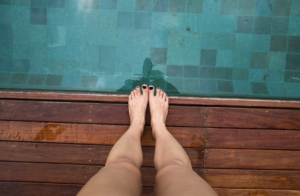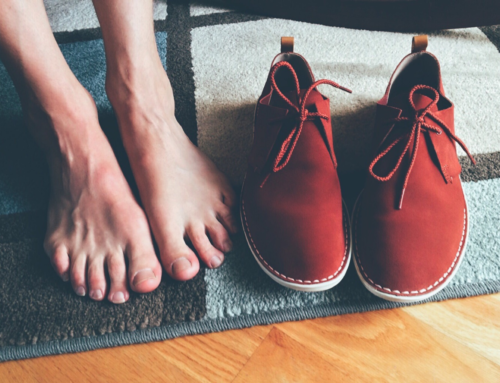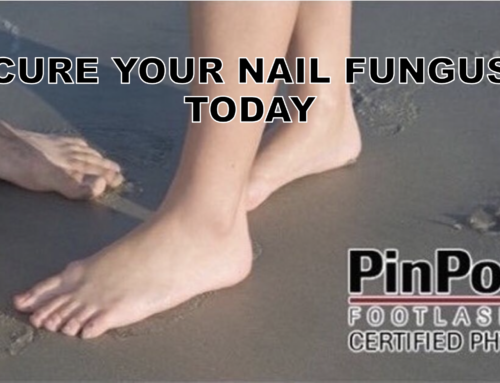Some people love the water. From the moment they first learn how to swim, they can’t wait to dive back into a pool. But not everyone has a pool in their backyard. Some people have to go to public pools to go swimming. They can go swimming in the same pool for years without even thinking about the dangers involved. Then one day, they get out of the pool and start putting on their shoes, only to notice strange spots on their toes.
What they had never realized was that people with toenail fungus go to public pools, too. When these people walk around the pool areas without wearing shoes, their toenail fungus could spread to the area surrounding the pool. If you step in the same spots that the people with toenail fungus had stepped previously, you can end up with the same nail fungal infection.
How do people get infected?
If someone is infected with nail fungus and spends the day at a public pool, they are putting everyone else at risk. All they have to do is simply walk around barefoot next to the pool. Anyone who steps in the spots where they stepped in could potentially become infected with toenail fungus.
For this reason, if you do still decide to go swimming in a public pool, you need to be cautious of the area around the water. Instead of walking around barefoot, put on some water shoes, or even sandals or flip-flops instead. This footwear will help prevent toenail fungus from infecting your feet. Also, when you rinse off in the pool’s shower area, make sure you continue to wear the same footwear. Public showers are often crawling with nail fungus.
There is one more thing that you should think about when you go to a public pool, or any pool or wet location, actually. Toenail fungus thrives in moist places. If you don’t dry off your feet after getting out of a pool or a shower, you are putting yourself at a greater risk of becoming infected with nail fungus. Always have a towel nearby and then use it to dry off as soon as possible. This will increase your chances of preventing nail fungus from infecting you.

Swimming Pools
Chlorine is able to kill things such as bacteria, parasites, and viruses. Although for one reason or another, it cannot kill fungi on the skin and nails. These types of fungi thrive mostly on the outskirts of the pool and jacuzzi, but also in it. This is more prevalent in public pools. It is shared with many other guests who could have the infection themselves. They transfer them onto the surfaces and into the water. Simply walking around the pool barefoot could help you treat a nail fungus, athlete’s foot, or even ringworm. So you are now probably thinking there is clearly nothing you can do to prevent this problem unless you avoid pools and jacuzzis altogether, but there are still ways to prevent obtaining this infection.
As long as you take precautions, you should be alright. Wearing water shoes around the pool will help keep the fungus from infecting you. You should also definitely leave them on when you go to the public shower. Nail fungal organisms thrive in shower environments. But if you actively try to prevent them from infecting you by wearing water shoes around the pool, you can continue to enjoy going for a swim whenever and wherever you’d like.
How to prevent nail fungus when swimming
It takes a few basic rules to follow if you would like to prevent a fungal infection. First and foremost, you should avoid walking barefoot around the pool areas, so wearing flip flops or sandals is important. Since fungi thrive on warm and moist surfaces, the pool surroundings are where you can expect them to be hiding. Make sure to shower before and after entering pools; there is a reason why most public swimming places have signs stating that.
Refrain from entering a pool if you have a severe fungal nail or athlete’s foot. Also, if you are experiencing diarrhea, you should avoid getting in chlorinated water, as it’ll spread the bacteria into the water, and the chlorine chemicals will worsen your case. Lastly, be sure to never swallow the water in these pools, for obvious reasons. Pools and jacuzzis can carry many diseases and bacteria. With that said, you can make sure to avoid being infected by following a few simple steps to practice good hygiene.

Laser Treatment for Toenail Fungus
If you have caught nail fungus, it can be easily treated using the FDA-approved PinPointe laser, which typically only takes one treatment. Other treatments like topical solutions and oral medication, are not as effective. Topical solutions have a very low cure rate. This is because the solution does not penetrate all the way through the nail bed. Oral medication is not recommended by our nail doctors. This is because it can lead to liver toxicity. You would need to have consistent blood tests throughout the course of taking the medication.
Our nail doctor in the Boston, MA area recommends this treatment. The PinPointe Laser treatment has the highest cure rate in the market. It has no side effects and no recovery period. As a result, you can go about your daily activities right after the treatment. Also, it is not painful.
If you have any signs of nail fungus, call us at (800) 672-0625 or visit our website for more information on our doctors at one of our over 150 locations.




